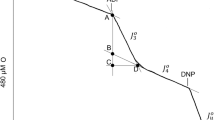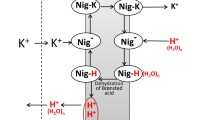Abstract
In this work, it was found that the ability of common uncouplers – carbonyl cyanide p-trifluoromethoxyphenyl-hydrazone (FCCP) and 2,4-dinitrophenol (DNP) – to reduce membrane potential of isolated rat liver mitochondria was diminished in the presence of millimolar concentrations of the known cytochrome c oxidase inhibitor – cyanide. In the experiments, mitochondria were energized by addition of ATP in the presence of rotenone, inhibiting oxidation of endogenous substrates via respiratory complex I. Cyanide also reduced the uncoupling effect of FCCP and DNP on mitochondria energized by succinate in the presence of ferricyanide. Importantly, cyanide did not alter the protonophoric activity of FCCP and DNP in artificial bilayer lipid membranes. The causes of the effect of cyanide on the efficiency of protonophoric uncouplers in mitochondria are considered in the framework of the suggestion that conformational changes of membrane proteins could affect the state of lipids in their vicinity. In particular, changes in local microviscosity and vacuum permittivity could change the efficiency of protonophore-mediated translocation.
Similar content being viewed by others
Abbreviations
- BLM:
-
bilayer phospholipid membranes
- BSA:
-
bovine serum albumin
- CCCP:
-
carbonyl cyanide m-chlorophenylhydrazone
- DNP:
-
2,4-dinitrophenol
- FCCP:
-
car-bonyl cyanide p-trifluoromethoxyphenylhydrazone
- FCS:
-
fluo-rescence correlation spectroscopy
- MC:
-
mitochondria
- TMRE:
-
tetramethylrhodamine ethyl ester (dye)
- Δψ:
-
mito-chondrial membrane potential
References
Skulachev, V. P. (1998) Uncoupling: new approaches to an old problem of bioenergetics, Biochim. Biophys. Acta, 1363, 100–124.
Cunha, F. M., Caldeira da Silva, C. C., Cerqueira, F. M., and Kowaltowski, A. J. (2011) Mild mitochondrial uncoupling as a therapeutic strategy, Curr. Drug Targets, 12, 783–789.
Feng, X. X., Zhu, W., Schurig-Briccio, L. A., Lindert, S., Shoen, C., Hitchings, R., Li, J. K., Wang, Y., Baig, N., Zhou, T. H., Kim, B. K., Crick, D. C., Cynamon, M., McCammon, J. A., Gennis, R. B., and Oldfield, E. (2015) Antiinfectives targeting enzymes and the proton motive force, Proc. Natl. Acad. Sci. USA, 112, 7073–7082.
Andreyev, A. Y., Bondareva, T. O., Dedukhova, V. I., Mokhova, E. N., Skulachev, V. P., Tsofina, L. M., Volkov, N. I., and Vygodina, T. V. (1989) The ATP/ADP-antiporter is involved in the uncoupling effect of fatty acids on mito-chondria, Eur. J. Biochem., 182, 585–592.
Starkov, A. A., Dedukhova, V. I., and Skulachev, V. P. (1994) 6-Ketocholestanol abolishes the effect of the most potent uncouplers of oxidative phosphorylation in mitochondria, FEBS Lett., 355, 305–308.
Hatefi, Y. (1975) Energy conservation and uncoupling in mitochondria, J. Supramol. Struct., 3, 201–213.
Weinbach, E. C., and Garbus, J. (1969) Mechanism of action of reagents that uncouple oxidative phosphorylation, Nature, 221, 1016–1018.
Lou, P. H., Hansen, B. S., Olsen, P. H., Tullin, S., Murphy, M. P., and Brand, M. D. (2007) Mitochondrial uncouplers with an extraordinary dynamic range, Biochem. J., 407, 129–140.
Dalla, V. L., Garcia-Argaez, A. N., Braga, A., Martinez-Vazquez, M., Grancara, S., Martinis, P., Agostinelli, E., and Toninello, A. (2014) An eudesman derivative from Verbesina persicifolia D. C. as a natural mild uncoupler in liver mitochondria. A new potential anti-obesity agent? Curr. Pharm. Des., 20, 253–261.
Khailova, L. S., Silachev, D. N., Rokitskaya, T. I., Avetisyan, A. V., Lyamsaev, K. G., Severina, I. I., Il’yasova, T. M., Gulyaev, M. V., Dedukhova, V. I., Trendeleva, T. A., Plotnikov, E. Y., Zvyagilskaya, R. A., Chernyak, B. V., Zorov, D. B., Antonenko, Y. N., and Skulachev, V. P. (2014) A short-chain alkyl derivative of rhodamine 19 acts as a mild uncoupler of mitochondria and a neuroprotector, Biochim. Biophys. Acta, 1837, 1739–1747.
Antonenko, Y. N., Denisov, S. S., Khailova, L. S., Nazarov, P. A., Rokitskaya, T., Tashlitsky, V. N., Firsov, A. M., Korshunova, G. A., and Kotova, E. A. (2017) Alkyl-substituted phenylamino derivatives of 7-nitrobenz-2-oxa-1,3-diazole as uncouplers of oxidative phosphorylation and anti-bacterial agents: involvement of membrane proteins in the uncoupling action, Biochim. Biophys. Acta, 1859, 377–387.
Chefurka, W. (1960) Studies on the inhibition of the mito-chondrial ATPase by reduction of the respiratory chain, Can. J. Biochem., 38, 1195–1214.
Johnson, D., and Lardy, H. (1967) Isolation of liver or kidney mitochondria, Methods Enzymol., 10, 94–96.
Akerman, K. E., and Wikstrom, M. K. (1976) Safranine as a probe of the mitochondrial membrane potential, FEBS Lett., 68, 191–197.
Perevoshchikova, I. V., Zorov, D. B., and Antonenko, Y. N. (2008) Peak intensity analysis as a method for estimation of fluorescent probe binding to artificial and natural nanoparticles: tetramethylrhodamine uptake by isolated mitochondria, Biochim. Biophys. Acta, 1778, 2182–2190.
Jung, D. W., Davis, M. H., and Brierley, G. P. (1989) Estimation of matrix pH in isolated heart mitochondria using a fluorescent probe, Anal. Biochem., 178, 348–354.
Copenhaver, J. H., and Lardy, H. A. (1952) Oxidative phosphorylations: pathways and yield in mitochondrial preparations, J. Biol. Chem., 195, 225–238.
Colowick, S. P., Kaplan, N. O., and Ciotti, M. M. (1951) The reaction of pyridine nucleotide with cyanide and its analytical use, J. Biol. Chem., 191, 447–459.
Andersen, O. S., Finkelstein, A., Katz, I., and Cass, A. (1976) Effect of phloretin on permeability of thin lipid membranes, J. Gen. Physiol., 67, 749–771.
McLaughlin, S., and Dilger, J. P. (1980) Transport of protons across membranes by weak acids, Physiol. Rev., 60, 825–863.
Liberman, E. A., Topaly, V. P., Tsofina, L. M., Jasaitis, A. A., and Skulachev, V. P. (1969) Mechanism of coupling of oxidative phosphorylation and the membrane potential of mitochondria, Nature, 222, 1076–1078.
Ting, H. P., Wilson, D. F., and Chance, B. (1970) Effects of uncouplers of oxidative phosphorylation on the specific conductance of bimolecular lipid membranes, Arch. Biochem. Biophys., 141, 141–146.
Bakker, E. P., Van den Heuvel, E. J., Wiechmann, A. H., and Van Dam, K. (1973) A comparison between the effectiveness of uncouplers of oxidative phosphorylation in mitochondria and in different artificial membrane systems, Biochim. Biophys. Acta, 292, 78–87.
Lee, A. G. (2004) How lipids affect the activities of integral membrane proteins, Biochim. Biophys. Acta, 1666, 62–87.
Benz, R., and Mclaughlin, S. (1983) The molecular mechanism of action of the proton ionophore FCCP (carbonyl cyanide p-trifluoromethoxyphenylhydrazone), Biophys. J., 41, 381–398.
Sokolov, Y., Kozak, J. A., Kayed, R., Chanturiya, A. F., Glabe, C. F., and Hall, J. (2006) Soluble amyloid oligomers increase bilayer conductance by altering dielectric structure, J. Gen. Physiol., 128, 637–647.
Author information
Authors and Affiliations
Corresponding author
Additional information
Original Russian Text © L. S. Khailova, T. I. Rokitskaya, E. A. Kotova, Y. N. Antonenko, 2017, published in Biokhimiya, 2017, Vol. 82, No. 10, pp. 1489-1496.
Rights and permissions
About this article
Cite this article
Khailova, L.S., Rokitskaya, T.I., Kotova, E.A. et al. Effect of cyanide on mitochondrial membrane depolarization induced by uncouplers. Biochemistry Moscow 82, 1140–1146 (2017). https://doi.org/10.1134/S0006297917100066
Received:
Revised:
Published:
Issue Date:
DOI: https://doi.org/10.1134/S0006297917100066




